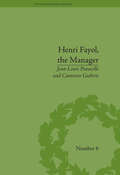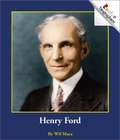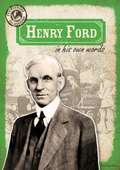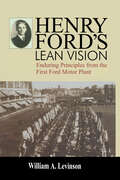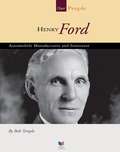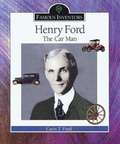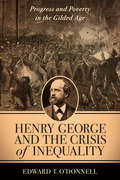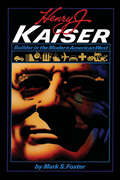- Table View
- List View
Henkel KGaA: Detergents Division
by David J. ArnoldHenkel has to decide whether to replace its strong local detergent brands in Italy and Spain with its leading international brand, Persil. It faces pressure from retailers for international brand standardization. Its competitors, including P&G and Unilever, are consolidating their portfolios around a few global "power brands."
Henkel: Building a Winning Culture
by Natalie Kindred Robert L. SimonsThis case illustrates a CEO-led organizational transformation driven by stretch goals, performance measurement, and accountability. When Kasper Rorsted became CEO of Henkel, a Germany-based producer of personal care, laundry, and adhesives products, in 2008, he was determined to transform a corporate culture of "good enough" into one singularly focused on winning in a competitive marketplace. Historically, Henkel was a comfortable, stable place to work. Many employees never received negative performance feedback. Seeking to overturn a pervasive attitude of complacency, Rorsted implemented a multi-step change initiative aimed at building a "winning culture." First, in November 2008, he announced a set of ambitious financial targets for 2012. As financial turmoil roiled the global economy, he reaffirmed his commitment to these targets, sending a clear signal to Henkel employees and external stakeholders that excuses were no longer acceptable. Rorsted next introduced a new set of five company values-replacing the previous list of 10 values, which few employees could recite by memory-the first of which emphasized a focus on customers. He also instituted a new, simplified performance management system, which rated managers' performance and advancement potential on a four-point scale. The system also included a forced ranking requirement, mandating that a defined percentage of employees (in each business unit and company-wide) be ranked as top, strong, moderate, or low performers. These ratings significantly impacted managers' bonus compensation. In late 2011-the time in which the case takes place-Henkel is well on its way to achieving its 2012 targets. Having shed nearly half its top management team, along with numerous product sites and brands, Henkel appears to be a leaner, more competitive, "winning" organization.
Henkel: Building a Winning Culture
by Natalie Kindred Robert L. SimonsThis case illustrates a CEO-led organizational transformation driven by stretch goals, performance measurement, and accountability. When Kasper Rorsted became CEO of Henkel, a Germany-based producer of personal care, laundry, and adhesives products, in 2008, he was determined to transform a corporate culture of "good enough" into one singularly focused on winning in a competitive marketplace. Historically, Henkel was a comfortable, stable place to work. Many employees never received negative performance feedback. Seeking to overturn a pervasive attitude of complacency, Rorsted implemented a multi-step change initiative aimed at building a "winning culture." First, in November 2008, he announced a set of ambitious financial targets for 2012. As financial turmoil roiled the global economy, he reaffirmed his commitment to these targets, sending a clear signal to Henkel employees and external stakeholders that excuses were no longer acceptable. Rorsted next introduced a new set of five company values-replacing the previous list of 10 values, which few employees could recite by memory-the first of which emphasized a focus on customers. He also instituted a new, simplified performance management system, which rated managers' performance and advancement potential on a four-point scale. The system also included a forced ranking requirement, mandating that a defined percentage of employees (in each business unit and company-wide) be ranked as top, strong, moderate, or low performers. These ratings significantly impacted managers' bonus compensation. In late 2011-the time in which the case takes place-Henkel is well on its way to achieving its 2012 targets. Having shed nearly half its top management team, along with numerous product sites and brands, Henkel appears to be a leaner, more competitive, "winning" organization.
Henkel: Building a Winning Culture (B)
by Natalie Kindred Robert L. SimonsThis case, an update on "Henkel: Building a Winning Culture (A)," describes Henkel's strong performance against its tough 2012 objectives, as well as the new objectives CEO Kasper Rorsted set for 2016.
Hennes & Mauritz, 2000
by John R. Wells Galen DanskinIn 2000, Hennes & Mauritz (H&M) was the second-largest and most global player in the fashion retail business. It operated 682 stores, 80% of them outside its home country of Sweden, and achieved revenues of $3.0 billion and operating profits of $375 million. In 1999, when H&M announced plans to enter the U.S., sales had grown 20% per year and operating profits, 30%, for a decade. After the August announcement of U.S. expansion plans, its share price hit a record $35 (a P/E of over 90). But the new millennium brought challenges and uncertainty. In March 2000, the first nonfamily CEO, Fabian Mansson, resigned after only two years at the helm and the company issued a profits warning. In September 2000, H&M's share price closed at $18.68, a fall of nearly 50% from the prior year. Meanwhile Gap, the world's leading fashion retailer with revenues of $13.7 billion, was adding 600 stores a year and expanding into Europe from its U.S. base. Rolf Erikson, Masson's replacement, impressed few analysts and questions lingered about H&M's ability to maintain its rate of expansion. What did new CEO Rolf Erikson need to do to avert the threat from Gap and restore the company's fortunes?
Hennes & Mauritz, 2012
by John R. Wells Galen Danskin"In 2012, Hennes & Maurtiz (H&M) was the second-largest specialty apparel retailer in the world. Sales for fiscal 2012 were $18.1 billion and operating profits were $3.3 billion. H&M operated 2,776 stores, 93% of them outside its home base of Sweden. Over the past decade, H&M had passed Gap in sales, but the company had failed to keep up with Inditex's growth and its Spanish rival had larger sales and greater profitability than H&M. H&M had also lagged behind Inditex in supply pipeline speed, brand diversification, online retail presence, and expansion into China. Meanwhile, the world's leading hypermarket chains, including Wal-Mart and Tesco, were making significant headway in apparel and challenge H&M's basic clothing segment. In 2012, CEO Karl-Johan Persson, grandson of the company's founder Erling Persson, promised increased expansion into underdeveloped markets, a stronger push to online retailing, and the launch of a major new retail brand. Whether Persson's plans were enough to catch up with Inditex remained to be seen."
Henri Fayol, the Manager (Studies in Business History #6)
by Jean-Louis Peaucelle Cameron GuthrieHenri Fayol is one of the most important management theorists of the twentieth century. Guthrie and Peaucelle present a study of Fayol's management, comparing the theories set out in his book with his hands-on experience and practice. The first English translation of the third part of Industrial and General Management appears as an Appendix.
Henry A. Abbati: Selected Writings (Routledge Studies in the History of Economics #119)
by Serena Di GaspareHenry A. Abbati was not an economist by profession. After retiring from business, in 1924 he published his first book, The Unclaimed Wealth: How Money Stops Production in which he expounded his theory of ‘effective demand’ (terminology of his own) and its differences with respect to current theories on economic fluctuations. He was advocating public intervention in the economy in the crisis. His second book, The Final Buyer marshalled his criticisms of current theories and further clarified salient aspects of his theory, such as ‘saving’ and its various definitions, the working of the banking system, the interest rate and the role of public works as a means of reducing unemployment. Later work in the 30s and 40s looked at full employment, reflections on the economic crisis and further analysis of the concept of unclaimed wealth. In many ways Abbati’s work in the twenties was an important precursor to Keynes’ Treatise on Money, though despite being admired by Robertson and indeed Keynes, his work is today largely unknown and entirely ignored by the numerous authors who have examined the debate of the twenties and thirties on the crises and business cycles and by academic opinion in general. In this book, Di Gaspare restores Abbati’s position as a pioneer in macroeconomic theory with a selection of his writings and a far reaching introduction to his contribution to the history of economic thought.
Henry A. Kissinger as Negotiator: Background and Key Accomplishments
by James K. Sebenius Laurence A. GreenCase
Henry Ford
by Wil Mara- Age-appropriate vocabulary- Clear linkage between text and photos- Includes archival reproductions where appropriate- Positioned in the middle Early Intervention range- Comprehensive glossary of "Words You Know"- Index makes navigating subject matter easy
Henry Ford in His Own Words
by Ryan NagelhoutHenry Ford, founder of the Ford Motor Company, didn't invent the car or even his famous assembly line. However, he was the innovator who made these things wildly successful. In fact, his practices and ideas shaped American life and business in the twentieth century, even helping the war effort in World War II, and continue to do so today. This biography uses quotations and writings to trace Henry Ford's rise from humble farm boy to thriving entrepreneur.
Henry Ford's Lean Vision: Enduring Principles from the First Ford Motor Plant
by William A. LevinsonJapanese manufacturers have made concepts like kaizen (continuous improvement), poka-yoke (error-proofing), and just-in-time famous. When the Japanese began to adopt these techniques from the Ford Motor Company during the early twentieth century, they knew exactly what they were getting: proven methods for mass-producing any product or delivering any service cheaply but well.Henry Ford's methods, however, went well beyond the synergistic and mutually supporting techniques that constitute what we now call lean manufacturing. They included the "soft sciences," the organizational psychology that makes every employee a partner in the drive for success. In Henry Ford's Lean Vision, William A. Levinson draws from Henry Ford's writings, the procedures in his factories, and historical anecdotes about the birth of lean in Japan to show that the philosophy that revolutionized Japanese manufacturing was the same philosophy that grew the Ford Motor Company into a global powerhouse -- and made the United States the wealthiest and most powerful nation on earth. Levinson reveals how Ford was ahead of other modern visionaries and discusses why the very ideas that made his company such a success were abandoned in his own country, and why they finally found acceptance in Japan. Henry Ford's Lean Vision is a hands-on reference that provides the reader with proven principles and methods that can be applied in any business or service enterprise. It covers all aspects of building and running a successful enterprise, including Ford's principles for human relationships and the management of physical resources.
Henry Ford: Automobile Manufacturer and Innovator
by Bob TempleA biography of the man responsible for mass producing the automobile in the early part of the twentieth century.
Henry Ford: The Car Man
by Carin T. FordA simple biography of the man who revolutionized American industry with his assembly-line production of automobiles.
Henry George and How Growth in Real Estate Contributes to Inequality and Financial Instability (Palgrave Studies on Henry George for the 21st Century)
by Edward NellThis Palgrave Pivot contextualizes Henry George as an important and uniquely American figure in the fields of economics and political economy, with special emphasis on the frontier and innovation. This book discusses George’s concept of rent as the result of economic progress, explains George’s argument that the rise in rents caused by economic progress in turn generates inequality and poverty, and examines the relevance of these ideas in today’s financialized global economy. This book adds to the very necessary discussion of whether our current financial industry is a benefit or a drain on human economic well-being.
Henry George and the Crisis of Inequality
by Edward O'DonnellThe remarkable explosion of American industrial output and national wealth at the end of the nineteenth century was matched by a troubling rise in poverty and worker unrest. As politicians and intellectuals fought over who to blame for this crisis, Henry George (1839--1897) published Progress and Poverty (1879), a radical critique of laissez-faire capitalism and its threat to the nation's republican traditions. His book, which became a surprise best-seller, offered a popular, provocative solution: a single-tax on land values. George's writings and years of social activism almost won him the mayor's seat in New York City in 1886. Though he lost the election, his ideas proved instrumental to shaping a progressivism that remains essential to tackling inequality today.Edward T. O'Donnell's exploration of George's life and times merges labor, ethnic, intellectual, and political history to illuminate the early militant labor movement in Gilded Age New York. O'Donnell locates in George's rise to prominence the beginning of a larger effort by American workers to regain control of the workplace and obtain economic security. The Gilded Age was the first but by no means last period in which Americans confronted the mixed outcomes of modern capitalism. George's accessible, forward-thinking ideas on democracy, equality, and freedom have tremendous value to ongoing debates over the future of unions, corporate power, Wall Street recklessness, regulation, and political polarization.
Henry George and the Crisis of Inequality: Progress and Poverty in the Gilded Age (Columbia History of Urban Life)
by Edward O'DonnellAmerica's remarkable explosion of industrial output and national wealth at the end of the nineteenth century was matched by a troubling rise in poverty and worker unrest. As politicians and intellectuals fought over the causes of this crisis, Henry George (1839–1897) published a radical critique of laissez-faire capitalism and its threat to the nation's republican traditions. Progress and Poverty (1879), which became a surprise best-seller, offered a provocative solution for preserving these traditions while preventing the amassing of wealth in the hands of the few: a single tax on land values. George's writings and years of social activism almost won him the mayor's seat in New York City in 1886. Though he lost the election, his ideas proved instrumental to shaping a popular progressivism that remains essential to tackling inequality today.Edward T. O'Donnell's exploration of George's life and times merges labor, ethnic, intellectual, and political history to illuminate the early militant labor movement in New York during the Gilded Age. He locates in George's rise to prominence the beginning of a larger effort by American workers to regain control of the workplace and obtain economic security and opportunity. The Gilded Age was the first but by no means the last era in which Americans confronted the mixed outcomes of modern capitalism. George's accessible, forward-thinking ideas on democracy, equality, and freedom have tremendous value for contemporary debates over the future of unions, corporate power, Wall Street recklessness, government regulation, and political polarization.
Henry George: Collected Journalistic Writings
by Kenneth C. Wenzer Henry GeorgeMore than a century after his death in 1897, Henry George remains one of the most original and influential economic thinkers in American history. His revolutionary theory on land taxation gained a tremendous following, reshaped the nation's political and economic debate, and continues today to be a widely discussed and controversial subject throughout the world. George's seminal work was Progress and Poverty (1879), but as a reformer, economist, journalist, and political candidate he wrote scores of articles on a vast array of topics, including political thought, election reform, immigration, labor, Lincoln, presidential campaigns, private property, socialism, industrialization, Ireland, Australia, the Chinese in California, and his race for mayor of New York City. His writing shaped a generation of statesmen and intellectuals, including Winston Churchill, Robert La Follette, Clarence Darrow, George Bernard Shaw, and Milton Friedman. Despite his profound influence on economic thought and American reform, he remains understudied, in part because many of his writings appeared in obscure journals, long-defunct daily newspapers, and long out-of-print collections. This four-volume set rectifies this problem by gathering all of George's hard-to-find articles and essays in one comprehensive edition. It also includes the first biographical sketch of him, written in 1884 and never before republished, as well as numerous articles he wrote during his tour of Australia in 1890. Edited by noted George scholar Kenneth C. Wenzer, each article is reprinted in its original form with annotations. There is a general introduction to each volume. A timeline of George's activities and travels is also included.
Henry Heinz: Making Markets for Processed Foods
by Nancy F. KoehnOutlines many of the supply-side innovations, such as improved transportation, communication, and technological developments, that greatly expanded the productive capacity of the United States in the late 19th century. Explores a range of demand-side shifts, including rising incomes, population growth, and urbanization, that changed consumers' wants and needs. These developments, taken together with those on the supply side, altered the nature of the American economy, ushering in widespread industrialization, markets of unprecedented size, and consumption on an entirely new scale. Investigates how, within this context, H.J. Heinz created a successful food-processing business in the last three decades of the 19th century.
Henry J. Kaiser: Builder in the Modern American West
by Mark S. Foster&“His standing as a lesser-known in a business pantheon that would include such names as Ford and Carnegie makes this work of some scholarly importance.&” —Library Journal In the 1940s Henry J. Kaiser was a household name, as familiar then as Warren Buffett and Donald Trump are now. Like a Horatio Alger hero, Kaiser rose from lower-middle-class origins to become an enormously wealthy entrepreneur, building roads, bridges, dams, and housing. He established giant businesses in cement, aluminum, chemicals, steel, health care, and tourism. During World War II, his companies built cargo planes and Liberty ships. After the war, he manufactured the Kaiser-Frazer automobile. Along the way, he also became a major force in the development of the western United States, including Hawaii. Henry J. Kaiser: Builder in the Modern American West is the first biography of this remarkable man. Drawing on a wealth of archival material never before utilized, Mark Foster covers Kaiser&’s entire life (1882–1967), painting an evenhanded portrait of a man of driving ambition and integrity, demonstrating Kaiser as the prototypical &“frontier&” entrepreneur who often used government and union support to tame the &“wilderness.&” Today the Kaiser legacy remains great. Kaiser played a major role in building the Hoover, Bonneville, Grand Coulee, and Shasta dams. The Kaiser-Permanente Medical Care Program still provides comprehensive health care for millions of subscribers. Kaiser-planned communities remain in Los Angeles; San Francisco; Portland, Oregon; and Boulder City, Nevada. Kaiser Engineers was actively engaged in hundreds of huge construction jobs across the nation and around the world. US and business historians, scholars of the modern West, and general readers will find much to absorb in this well-written biography.
Henry Kissinger: Negotiating Black Majority Rule in Rhodesia (A)
by James K. Sebenius Laurence A. GreenIn 1976, a growing crisis in Southern Africa drew the attention of United States Secretary of State Henry A. Kissinger. White Rhodesian leader Ian Smith's refusal to accede to black majority rule threatened to widen into a regional conflict involving apartheid South Africa and newly independent leftist African states. Kissinger and others feared that the region was on the brink of becoming a new battleground in the Cold War. In light of these developments Kissinger decided to intervene, seeking a negotiated solution that might bring about a peaceful end to minority rule. The account in this case carefully describes—but does not analyze nor draw lessons from—these challenging circumstances.
Henry Kissinger: Negotiating Black Majority Rule in Rhodesia (A)
by James K. Sebenius Laurence A. GreenIn 1976, a growing crisis in Southern Africa drew the attention of United States Secretary of State Henry A. Kissinger. White Rhodesian leader Ian Smith's refusal to accede to black majority rule threatened to widen into a regional conflict involving apartheid South Africa and newly independent leftist African states. Kissinger and others feared that the region was on the brink of becoming a new battleground in the Cold War. In light of these developments Kissinger decided to intervene, seeking a negotiated solution that might bring about a peaceful end to minority rule. The account in this case carefully describes-but does not analyze nor draw lessons from-these challenging circumstances.
Henry Kissinger: Negotiating Black Majority Rule in Rhodesia (B)
by James K. Sebenius Laurence A. GreenIn 1976, United States Secretary of State Henry A. Kissinger conducted a series of intricate, multiparty negotiations in Southern Africa to persuade white Rhodesian leader Ian Smith to accede to black majority rule. Conducted near the end of President Gerald Ford’s term in office and against substantial U.S. domestic opposition, Kissinger’s efforts culminated in Smith’s public announcement that he would accept majority rule within two years. This set the stage for the later Lancaster House negotiations that resulted in the actual transition to black majority rule. The account in this case carefully describes—but does not analyze nor draw lessons from—these challenging negotiations.

